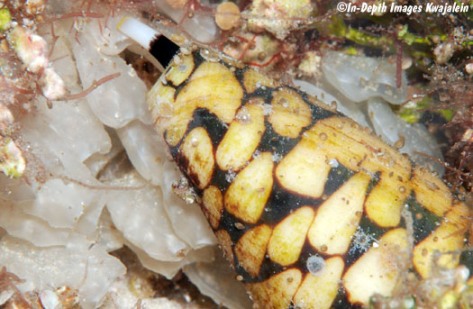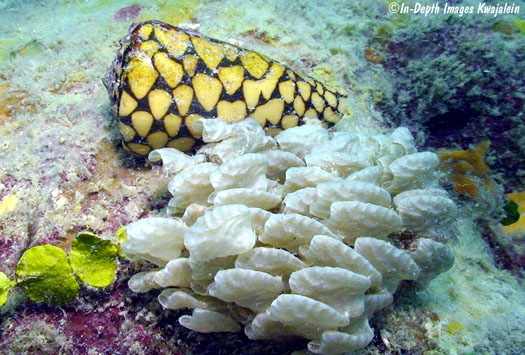Reproduction
 The marbled cone snail is dioecious, which literally
translates to “two houses.” This means they have separate sexes
and separate sex organs, so they are not hermaphrodites, like
other gastropods such as
Fumonelix archeri.
They reproduce sexually by internal fertilization. C.
marmoreus undergoes protostome development; this means its
cells go through a mitotic division known as spiral cleavage and
the blastopore develops into the mouth of the organism.
Schizocoelus development, which occurs when the gut is independent of the mesoderm
tissue during formation of the coelom, is part of protostome
development. An example of another organism that undergoes
protostome development is the
Common Green Bottle Fly. The
giraffe is an example of an animal that
undergoes deuterstome development.
The marbled cone snail is dioecious, which literally
translates to “two houses.” This means they have separate sexes
and separate sex organs, so they are not hermaphrodites, like
other gastropods such as
Fumonelix archeri.
They reproduce sexually by internal fertilization. C.
marmoreus undergoes protostome development; this means its
cells go through a mitotic division known as spiral cleavage and
the blastopore develops into the mouth of the organism.
Schizocoelus development, which occurs when the gut is independent of the mesoderm
tissue during formation of the coelom, is part of protostome
development. An example of another organism that undergoes
protostome development is the
Common Green Bottle Fly. The
giraffe is an example of an animal that
undergoes deuterstome development.
 The female
marbled cone snail lays hundreds of eggs in egg capsules, as
shown to the left (the white coral-looking stuff). A few of
these eggs hatch and even fewer mature into adults. Those eggs
that do hatch, however, hatch into miniature cone snails, as
opposed to larval forms. This is an example of an r-selected
reproductive strategy, where a small organism develops rapidly,
reproduces early with many offspring, and provides little to no
care for their offspring.
The female
marbled cone snail lays hundreds of eggs in egg capsules, as
shown to the left (the white coral-looking stuff). A few of
these eggs hatch and even fewer mature into adults. Those eggs
that do hatch, however, hatch into miniature cone snails, as
opposed to larval forms. This is an example of an r-selected
reproductive strategy, where a small organism develops rapidly,
reproduces early with many offspring, and provides little to no
care for their offspring.
Continue to Interactions
Return to Home
Visit MultipleOrganisms.net
Visit the UW-La
Crosse Website
Contact Information